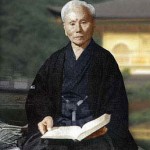Master GIchin Funakoshi was born in the mid-to-late 19th Century (10 November 1868, interestingly this is the year of the Meiji Restoration) in Shuri, Okinawa. He, as so many of the classic masters were reported to be, is reported to have been a weak and sickly young man that his parents would send for Karate training in order to become strong and healthy. His training went very well and, coupled with a traditional Chinese Medicine prescription of certain herbs, Funakoshi did indeed become stronger. And we’re the better for it, as the man who would be Master Gichin Funakoshi would also eventually become the grandfather of modern karate.
As was mentioned, he was reported to be a sickly young boy, sent to train under Itosu Anko to become stronger. As time went on, Funakoshi would become stronger, and would also become one of his prized students. Eventually, he would train under Anko’s master, Bushi Matsumura. From these classic masters, Funakoshi would train in Shuri-Te and Shorin-Ryu*, eventually synthesizing them into his own style – Shotokan Karate.
Master Funakoshi wasn’t a rich man, and would move from Shuri, Okinawa to Suidobata, Japan in 1922 to be a cleaner at the prefecture dormitory. His work was to clean the dormitory during the day, but his passion was to teach karate – and he taught the students in the evenings… The students would pay what they could, as was the custom for martial arts training at the time, and soon after he would open a dojo in Meshojuku. This was a Shuri-Te/Shorin-Ryu Dojo, as he had not yet synthesized and developed Shotokan into an official style at this time.
What is interesting is that karate during Funakoshi’s time was considered a ‘savage’ and ‘pagan’, and was sort of like the young, annoying kid that hung around with the older ones, vying for attention. In a post Sino-Japanese and Great War era, Japan was spending a lot of time and effort to shape its Japanese nature, and spent a lot of time delineating “Japanese” values from the rest of the world. Many of these values would be deeply rooted in, ironically, classic Japanese practices, including those of the Samurai – which were only recently challenged, and even refuted, in the Meiji Restoration era.
It was Master Funakoshi who would challenge the conceptions of Karate being “savage” and “pagan”, developing his own synthesis of his masters’ styles into what would become Shotokan. His style would take the name based on after his pen name (Shoto, or “Pine breeze”) – in one of his first dojos, his students would make a wooden plague for the doorway, calling it “Shoto’s House”, or “Shoto Kan”.
Eventually his work would overcome the prejudices and garner formal recognition for karate as a Japanese Martial Art in 1941. Funakoshi would bring Karate practice almost to the same level of respect as Jujitsu, which was considered to be the Japanese martial art at the time.
What is interesting is that all of this work really began when he was a youthful 53 years old! One of the major things that he did was what many would call ‘minor’. He changed the written term of Kara Te from the meaning of “Chinese Hand”, commonly used at the time, to “Empty Hand”; this would separate the Chinese root of Karate for many people, allowing Japan to adopt it fully as ‘homegrown’… which would cause problems about 65 years later when the reboot of the Karate Kid franchise was launched – as many people who didn’t know this tidbit of information ended up swarming the message boards with statements like “that’s Kung Fu, not Karate”, etc.
Beyond the semantic changes, Master Funakoshi would take on many students in his career who would go on to further Karate by either creating their own styles (as he did) or bringing Karate to the Western world. He would teach hundreds of students, but about eight stand out – including his own son (Gigo Funakoshi), and a man named Hinonori Otsuka who would go on to develop Wado-Ryu. It is said that Funakoshi wouldn’t go anywhere or do any demonstrations without Otsuka, until the two would have philosophical differences in 1930.
Speaking of philosophical differences, I often wonder what Master Funakoshi would think about the development of the myriad of styles he would be grandfather to, considering that he wasn’t one for competitions, records, or championships; he focused his emphasis on individual self-development and perfection. His approach was not fully agreed upon by everyone he trained, as his son (Gigo) would go on to encourage kumite (free sparring) in his teaching career. Unfortunately, Gigo predeceased his father by over ten years, but this does show where the adoption of kumite in training may have come from. But I am still curious about what Master Funakoshi might think about the state of modern Karate, where ‘sparring’ has become a prerequisite for promotion, and how competition-focused many karateka have become…
I have one of my favourite quotes of Master Funakoshi’s engraved on my iPod that I believe encapsulates his ideology: “Karateka must act on the side of justice at all times.” It’s an ideology that I strongly support and share and, honestly, is one of the reasons for this website. I believe that Master Funakoshi’s approach of Karate as a tool for personal betterment is fundamental, and logically extends to helping others – which is why I hold Martial Artists to a very high standard.
For those interested in more, here is his life in his own words.
* Shuri-Te is named after the region of Shuri, basically meaning “Hand of Shuri” or Shuri’s fighting style; while Shorin-Ryu is the “Shaolin School”, with “Shorin” being the Japanese translation for the Mandarin word “Shaolin”.


